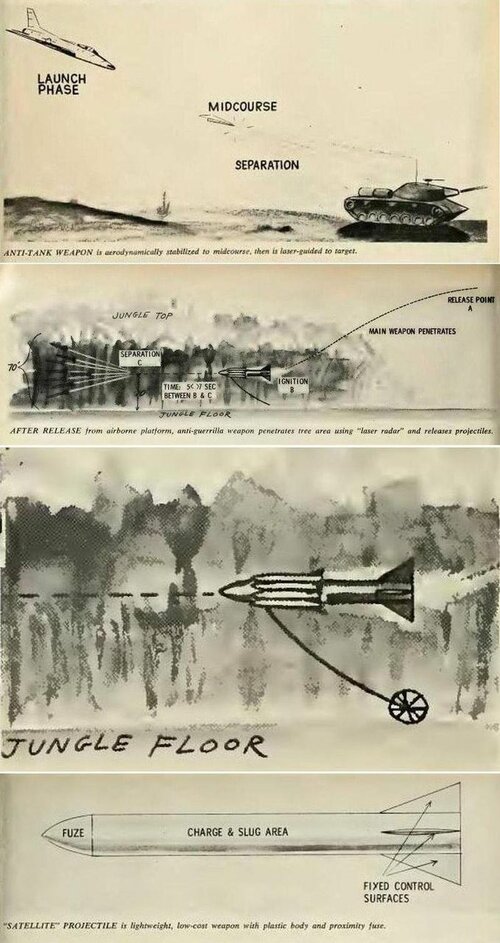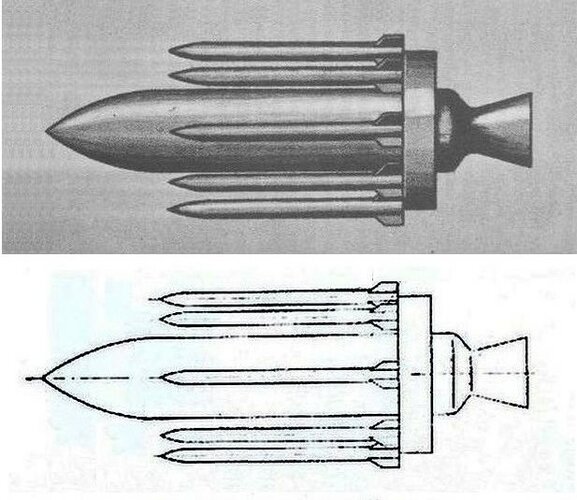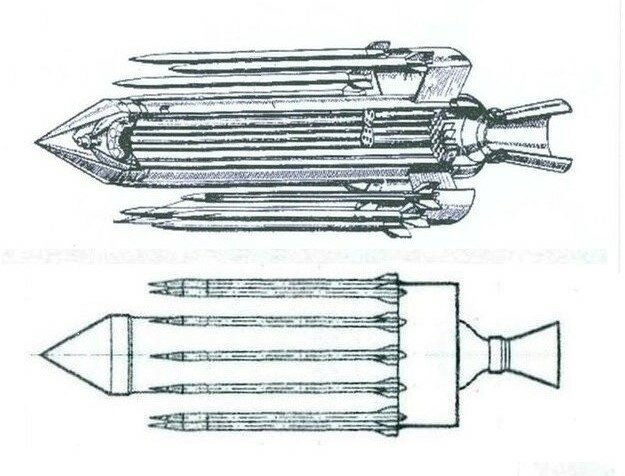klem
I really should change my personal text
- Joined
- 7 March 2015
- Messages
- 618
- Reaction score
- 1,248
In the review "Missiles and Rockets Dec.14,1965.p34" . An article discusses a missile, initiated and projected by the Office of Scientific Research of the Air Force and assisted in some details by several groups Air Force R&D as well as industry. - A tactical missile with multiple warheads six or seven projectiles (satellites: a light weapon with a plastic body and a proximity rocket), would be able to flush out guerrillas in a wooded area or destroy a tank, it is dropped from an airplane or a helicopter. The anti-tank version of the missile is called "Big Bill" and the anti-guerrilla version called "Big Marc".
The anti-tank version, "Big Bill", is launched at relatively high speeds compared to the anti-guerrilla missile. Both weapons, however, use a sense and guide system. In a real tank attack, the pilot of the aircraft visually aims at his target. From the time the pilot presses the fire button to maintain rocket ignition until the weapon reaches midcourse the missile is unguided and only stabilized by aerodynamic way. Halfway through, however, the laser beam is reflected off the tank and picked up by an array of sensors in the missile's nose. This laser feedback can also be enhanced by infrared emissions from the tank itself, so the sensors determine the necessary corrections to the missile's trajectory and the dispersion of satellite projectiles.
The primary propulsion system is a paper rocket engine weighing between 125 and 150 pounds. fully charged with propellant. The anti-guerrilla version, "Big Marc", is an anti-personnel missile weighing approximately 125 pounds. identical to the anti-tank weapon, would have the approximate form of a 100-1b bomb. Release would occur at altitudes ranging from approximately 500 feet down to the tops of the trees level. The missile would travel in a ballistic trajectory between 40 and 50 feet above the ground until it reached a specified altitude, then, the missile would stabilize and fly horizontally,
The time at which withdrawal is initiated would be determined by an optical altimeter and would be accomplished by aerodynamic lift provided by detachable wings supplemented by solid rocket thrust. After stabilizing, the missile with terrain following guidance would continue to be propelled for several additional seconds of flight, while making the necessary turns to avoid obstacles on the ground. the missile will contain a “laser radar” type system. The advantage of such a system is that its unambiguous return signal results in the smallest possible logic system for guidance signals. the confusion introduced by the foliage could be filtered out. Laser detectors, operating in the IR range, will be able to recognize the pattern of guerrilla concentrations or encampments or can target ground fire.
The anti-tank version, "Big Bill", is launched at relatively high speeds compared to the anti-guerrilla missile. Both weapons, however, use a sense and guide system. In a real tank attack, the pilot of the aircraft visually aims at his target. From the time the pilot presses the fire button to maintain rocket ignition until the weapon reaches midcourse the missile is unguided and only stabilized by aerodynamic way. Halfway through, however, the laser beam is reflected off the tank and picked up by an array of sensors in the missile's nose. This laser feedback can also be enhanced by infrared emissions from the tank itself, so the sensors determine the necessary corrections to the missile's trajectory and the dispersion of satellite projectiles.
The primary propulsion system is a paper rocket engine weighing between 125 and 150 pounds. fully charged with propellant. The anti-guerrilla version, "Big Marc", is an anti-personnel missile weighing approximately 125 pounds. identical to the anti-tank weapon, would have the approximate form of a 100-1b bomb. Release would occur at altitudes ranging from approximately 500 feet down to the tops of the trees level. The missile would travel in a ballistic trajectory between 40 and 50 feet above the ground until it reached a specified altitude, then, the missile would stabilize and fly horizontally,
The time at which withdrawal is initiated would be determined by an optical altimeter and would be accomplished by aerodynamic lift provided by detachable wings supplemented by solid rocket thrust. After stabilizing, the missile with terrain following guidance would continue to be propelled for several additional seconds of flight, while making the necessary turns to avoid obstacles on the ground. the missile will contain a “laser radar” type system. The advantage of such a system is that its unambiguous return signal results in the smallest possible logic system for guidance signals. the confusion introduced by the foliage could be filtered out. Laser detectors, operating in the IR range, will be able to recognize the pattern of guerrilla concentrations or encampments or can target ground fire.



